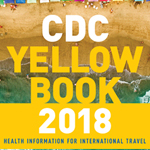Our Partners
Today’s infectious disease challenges require collaboration and coordination with a wide variety of stakeholders and partners to advance infectious disease prevention and control. Together, NCEZID and its partners are able to accomplish more than any organization or institution can by working alone. Our diverse programs are supported by a variety of valuable stakeholders and partners including (but not limited to):
- State and local health departments
- Professional organizations
- National medical associations
- Patient safety advocates and organizations
- Businesses
- Academia
- Other federal agencies
- Non-governmental organizations
Our work would not be possible without the help and support of these partners.
Partnership in Action
CDC working with partners on new rapid rabies test that could revolutionize testing and treatment

September 28 is World Rabies Day, a global day of action and awareness for rabies prevention. Rabies kills about 60,000 people annually, mostly in Africa and Asia. Rabies is nearly always fatal once symptoms appear, so identifying potential exposures and starting post-exposure treatment early is critical to a patient’s survival. One of the ways CDC is working to stop rabies is by collaborating with partners to develop, evaluate, and promote the use of a new rabies test that can more easily and precisely diagnose rabies infection in animals.
Hatcheries work with CDC to teach customers how to prevent human Salmonella infections from backyard flocks

In 2018, CDC and multiple states continue to investigate several multistate outbreaks of Salmonella infections linked to live poultry, with 212 illnesses in 44 states reported during the first half of the year alone. To keep customers and workers safe, CDC initiated partnerships with hatcheries across the country to take action to prevent Salmonella infections and better educate customers.
Healthier and safer in the water

With temperatures soaring this summer, many Americans are heading to public pools and water playgrounds at waterparks, community rec centers, hotels/motels, and apartment/condo complexes to cool down. A partnership between CDC and the Council for the Model Aquatic Health Code (CMAHC) is helping make public aquatic venues healthier and safer for swimmers and aquatics staff.
Protecting travelers’ health

CDC Health Information for International Travel (more commonly known as the Yellow Book) is the definitive resource for preventing illness and injury in a globalized world. The book provides the U.S. government’s health recommendations for international travel, including vaccine and drug information, disease maps and country-specific disease information, and detailed precautions for specific types of travelers. The Yellow Book is published biennially through a partnership between CDC’s Travelers’ Health Branch, the CDC Foundation, and Oxford University Press. Travelers’ Health coordinates a comprehensive update to the book’s content for each new edition.
Advanced Molecular Detection (AMD): The power of innovation and partnerships to advance public health

More than 400 external partners and CDC staff gathered in Atlanta as CDC and the Association of Public Health Laboratories (APHL) hosted the fourth annual AMD Day 2017 on September 25 and 26. The event expanded to 2 days in order to cover all of the science. AMD combines powerful technologies (DNA sequencing and advanced computing) to solve complex infectious disease mysteries, ultimately saving lives and reducing costs.
Partnering to prevent illnesses shared between people and pets

Did you know that 3 out of every 5 new human sicknesses come from bugs or other animals? Every year, tens of thousands of Americans will get sick from diseases spread between animals and people. These are known as zoonotic diseases, and CDC is always tracking and reporting these diseases to help people stay healthy. CDC’s One Health Office partners with physicians, veterinarians, ecologists, and many others to protect Americans by leading a public-private partnership to prevent diseases that are shared between people and their pets.
NCEZID partners with CDC Foundation and Pfizer on cryptococcal screening in South Africa

The National Center for Emerging and Zoonotic Infectious Diseases (NCEZID) and the CDC Foundation are using a grant from Pfizer to tackle cryptococcal meningitis (CM), a leading cause of death among people with HIV/AIDS. Through this partnership, screening strategies and costs are evaluated to provide policymakers and program implementers with the information they need to turn policy into action. Screening and pre-emptive treatment for early cryptococcal disease offer the opportunity to reduce burdens on health systems and to save lives.
CDC and BD partner to fight Zika

CDC’s Advanced Molecular Detection (AMD) Program is transforming disease detection and response through next-generation genomic sequencing and other advanced laboratory technologies. Partnerships are critical for implementing innovative AMD methods, which can produce cost-effective and reliable diagnostics and improve public health outcomes. As of October 2016, CDC is working with BD (Becton, Dickinson and Company) in Puerto Rico on a project to develop and validate diagnostic assays for Zika virus on the company’s BD MAX™ system, which is a complete, fully-automated, real-time molecular testing platform.
World leaders partner to combat antibiotic resistance

In September 2016, world leaders convened at the United Nations General Assembly in New York to discuss one of the biggest threats to global health—antibiotic resistance. All 193 member states signed on to combatting antibiotic resistance through a declaration to reverse the devastating trend that has resulted from the inappropriate use of antibiotics.
Delivering a cure: Airline helps CDC save lives

The Centers for Disease Control and Prevention (CDC), working closely with Delta Airlines and other key partners, helped three critically ill children in Haiti receive the lifesaving medication they needed within hours.
Turning human waste into affordable fuel in Kenya

CDC is committed to increasing access to basic sanitation services, especially in under-developed countries where resources are limited. When a start-up group of recent university graduates approached CDC with an innovative idea—to provide toilets in households in need and use the human waste to make fuel briquettes—a new, collaborative partnership began.
Partnering with tribes to improve American Indian health

CDC’s National Center for Emerging and Zoonotic Infectious Diseases (NCEZID) and the National Center for Environmental Health (NCEH) joined forces with tribal and local health departments, the Indian Health Service, Arizona Department of Health Services, and other public and private partners to design a new tick control strategy. A pilot project, the RMSF Rodeo, started in 2012 and used long-lasting tick collars on dogs, monthly environmental pesticide applications, and community-based education about tick control and pet health.
Promoting antibiotic stewardship

Careful, judicious stewardship of antibiotics can help to improve patient outcomes, prevent death from resistant infections, slow resistance, and reduce healthcare costs. A new Association of State and Territorial Health Officials (ASTHO) report, developed in partnership with CDC, Combating Antibiotic Resistance: Policies to Promote Antimicrobial Stewardship Programs , outlines approaches for state health agencies to tackle the antibiotic resistance challenge.
100 partners work to promote safe injection practices

What can we do to make sure that the foundation of safe care is strengthened? Efforts to promote safe injection practices are underway. Led by CDC and the Safe Injection Practices Coalition, the One & Only Campaign aims to prevent infections by ensuring that every medical injection is a safe one.
- Page last reviewed: July 24, 2018
- Page last updated: July 24, 2018
- Content source:
Centers for Disease Control and Prevention
National Center for Emerging and Zoonotic Infectious Diseases (NCEZID)


 ShareCompartir
ShareCompartir